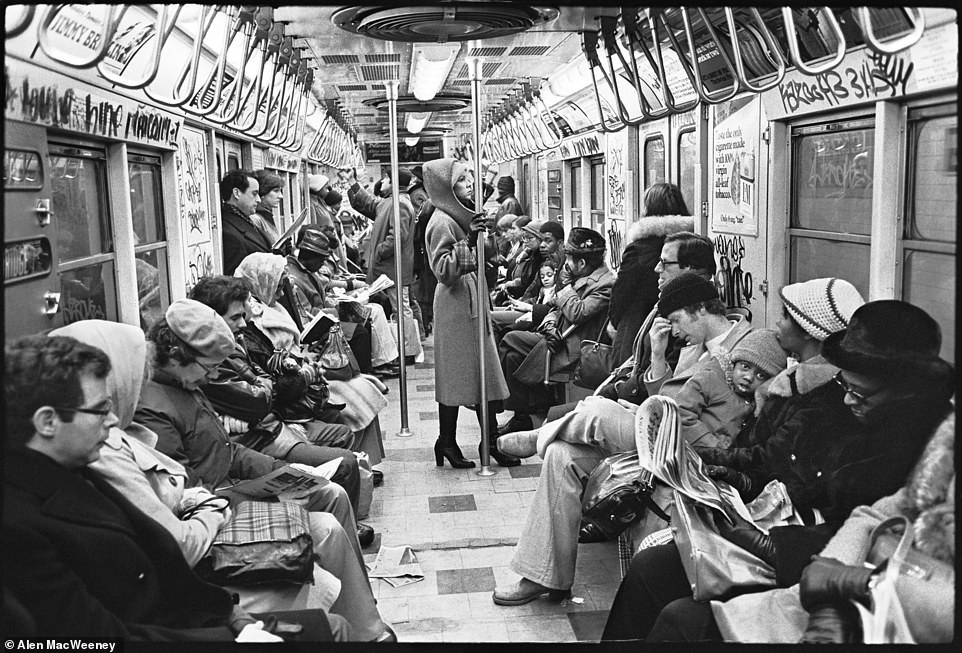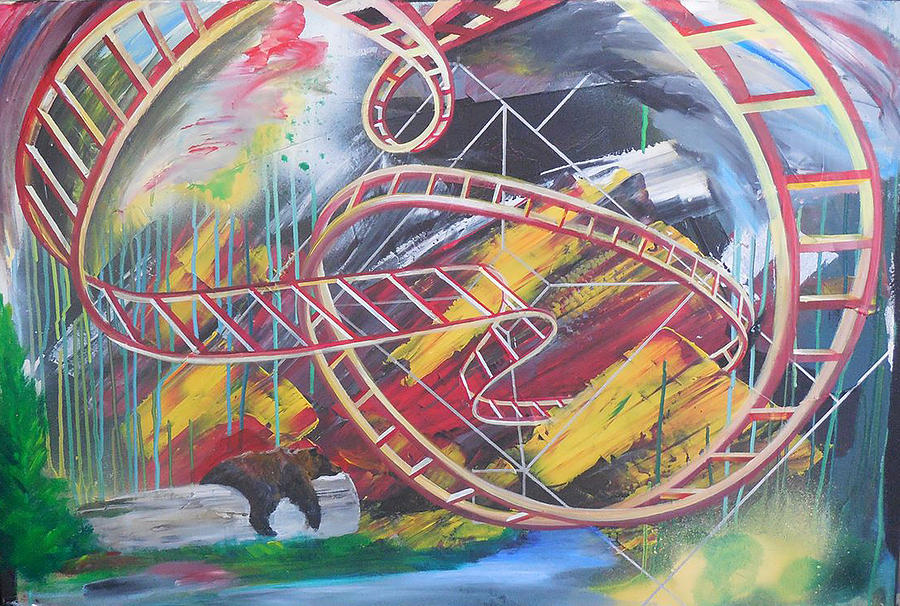|
Riding the "A"
May Swenson

I ride
the "A" train
and feel
like a ball-
bearing in a roller skate.
I have on a gray
rain-
coat. The hollow
of the car
is gray.
My face
a negative in the slate
window,
I sit
in a lit
corridor that races
through a dark
one. Strok-
ing steel,
what a smooth rasp—it feels
like the newest of knives
slicing
along
a long
black crusty loaf
from West 4th to 168th.
Wheels
and rails
in their prime
collide,
make love in a glide
of slickness
and friction.
It is an elation
I wish to pro-
long.
The station
is reached
too soon.
May Swenson's Riding the "A" was first published in 1963 in her collection To Mix with Time. By then, Duke Ellington and Ella Fitzgerald had already
made the New York City subway line famous for countless listeners via Billy
Strayhorn's song "Take the A Train":
You must take the A Train
To go to Sugar Hill way up in Harlem
If you miss the A Train
You'll find you've missed the quickest way to Harlem
Hurry, get on, now, it's coming
Listen to those rails a-thrumming (All Aboard!)
Get on the A Train
Soon you will be on Sugar Hill in Harlem
Strayhorn's song was all about how rapidly the A Train could lift you out of
the business world of downtown Manhattan and take you to a joyous land of
restaurants, bars, and entertainment venues such as the Apollo Theater and
The Lennox Lounge where jazz greats like Miles Davis, John Coltrane, and
Dizzy Gillespie performed. The lyric urges you to "hurry," once you hear
"those rails a-thrumming"; to get aboard as soon as the train arrives, and its
doors open.
Notice that the song doesn't place you inside the train, but on the platform
where you are hurrying so as not to miss "the quickest way to Harlem."
Swenson is less interested in getting to Columbus Circle or Sugar Hill,
Harlem than she is in the physical and spiritual experience of the ride itself.
She takes us inside the subway car, where her short, disjunctive lines
capture the spastic, jolting, swaying, rhythmic thrill that I felt when I was
riding the A train almost daily a few years before Swenson's poem first
appeared. Our poet makes us feel as if we are not so much "going
somewhere" as enjoying an exciting amusement park ride on a bumper car
or roller coaster.
Our excitement is heightened by the ride feeling a bit scary. There's
something almost surreal about the experience. We are jostled like "a ball
-bearing in a roller skate." We "sit / in a lit / corridor that races / through a
dark one," and we move "like / the newest of knives / slicing / along / a long
/ black crusty loaf / from West 4th to 186th."

The title of our poem, however, is not Riding the A Train, but Riding the "A."
A regular rider might drop the word "train" to affectionately nickname a
favorite mode of transportation. But Swenson drops the word and puts
quotation marks around her "A" to signal that another kind of ride is also
occurring here.
The poet has set herself a challenge. She will share the excitement and joy
that an imaginative ride on a NYC subway train, circa 1963, elicits; but she
will also share her delight at playing with that train's letter "A." (It may not
be a coincidence that the first letter in the alphabet occurs 39 times in this
39-line poem.)
Word after word in our poet's train of thought features what is arguably the
most primal letter in the alphabet. Long A occurs 7 times in her first 15 lines: a, train, skate, gray, rain, gray, slate, races. Swenson, however, is careful to
establish, but not make her entitled vowel too conspicuous. Her next 17 lines
feature 8 words (what, dark, rasp, along, a, black, loaf, rails)that sport a
short "a" which suspends the rhyming and lowers the temperature on the
letter's noticeability.
Swenson has fun playing with the alphabet's remaining four vowels; boldly
featuring "i" rhymes, both long and short (sit / lit; collide / glide; slickness /
friction); including one long "e" rhyme (steel / feels); a slant rhyme off "o"
(stroke / dark); and just one long and one short "u" in her poem (through /
crusty) to make sure that vowel is not kicked off her train.
There is a serious joke embedded in this endeavor. Trains run on rails that,
like parallel lines, never meet. Yet Swenson's poem is an attempt to bring
her A train and letter "a" together.
Our poem reaches a climax with erotic overtones, as "
wheels / and rails /
in their prime / collide / make love in a glide / of slickness and
friction" is followed by an "a" word that perfectly describes the joy our
poet's multi-layered ride delivers:
The accent in elation falls firmly on the "a." It's as if the word has chosen
that vowel (rather than its "e" or "i" or "o") to best express the "joyfulness or
exaltation of spirit" that dictionaries tell us the word denotes. Elation not
only describes our experience riding a train that feels like a roller coaster; it
also captures our delight as Swenson almost completes her playful ride on
the letter "a." To quote the final line of last month's favorite poem, "Crystal
Moment," both train and vowel are "running beautiful together."

But our poem is not yet over. When I rode the roller coaster as a child at
Bertram's Island in New Jersey, I always felt let down when the train raced
back into the station and my car stopped with a disconcerting jolt.
The thrill of riding Swenson's train, riding her ride, riding her "a," her
vowels, her love, are all metaphors for riding life itself.
We cannot get too much of this vibrant imaginative journey we call life. We
are sad that her and our elation is over, as,
Swenson's abrupt ending reminds us that all trains stop, all voices go silent.
The upward lilt of the "a" in "elation" slips off our tongues, ending too soon.
The spondaic, thumping emphasis on both syllables of
STA-TION
brings
everything to a standstill. "Station" has the final say— and stay—on this
exhilarating ride on Swenson's "A."

And another hundred people just got off of the train.
—Stephen Sondheim—
|